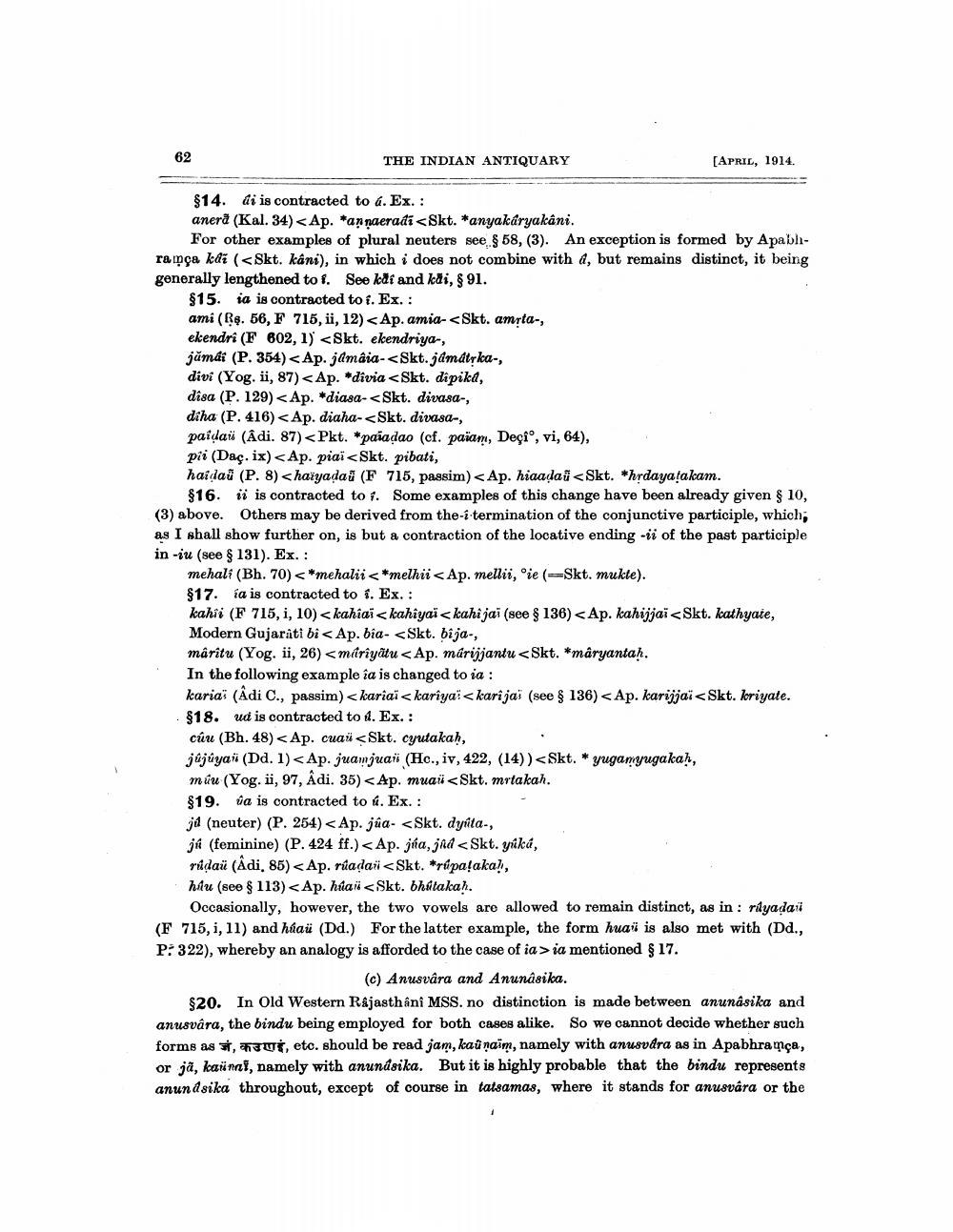________________
THE INDIAN ANTIQUARY
[APRIL, 1914.
$14. di is contracted to a. Ex.: anera (Kal. 34) < Ap. *annaeradi <Skt. *anyakaryakâni.
For other examples of plural neuters see $ 58, (3). An exception is formed by Apabiramça kdi ( Skt. kani), in which i does not combine with d, but remains distinct, it being generally lengthened to f. See kai and käi, s 91.
$15. ia is contracted to f. Ex.: ami (Re. 56, F 715, ii, 12) <Ap. amia- <Skt. amrta-, ekendri (F 602, 1) <Skt. ekendriya-, jămái (P. 354) Ap. jamaia-Skt. jamátrka-, divi (Yog. ii, 87) < Ap. *divia <Skt. dipika, disa (P. 129) <Ap. *diasa- <Skt. divasa-, diha (P. 416) <Ap. diaha- <Skt. divasa-, paidais (Âdi. 87) Pkt. *paiadao (cf. païam, Deçi°, vi, 64), pii (Daç. ix) <Ap. piai <Skt. pibati, haidai (P. 8) shaiyadau (F 715, passim) < Ap. hiaadau <Skt. *hrdayatakam.
$16. ii is contracted to i. Some examples of this change have been already given § 10, (3) above. Others may be derived from the-i-termination of the conjunctive participle, which, as I shall show further on, is but a contraction of the locative ending -i of the past participle in -iu (see § 131). Ex.:
mehali (Bh. 70) < *mehalii < *melhii < Ap. mellii, oie ( Skt. mukte). $17. ia is contracted to i. Ex.: kahit (F 715, i, 10) < kahiai <kahiyai < kahi jai (see § 136) <Ap. kahijjai <Skt. kathyate, Modern Gujarati bi< Ap. bia- <Skt. bija, maritu (Yog, ii, 26) < miriyatu < Ap. márijantu <Skt. *maryantah. In the following example ia is changed to ia : kariai (Adi C., passim) <kariai <kariya<karijai (see § 136) Ap. karijjaï<Skt. kriyate. $18. ud is contracted to 1. Ex.: cứu (Bh. 48) <Ap. cuaü <Skt. cyutakah, jujúyai (Dd. 1) <Ap. juamjuari (Hc., iv, 422, (14)) <Skt. * yugamyugakah, máu (Yog. ii, 97, Adi. 35)<áp. muaii <Skt, mvtakah. $19. úa is contracted to 6. Ex.: ja (neuter) (P. 254) <Ap. júa- <Skt. dyúta-, ja (feminine) (P. 424 ff.) <Ap. júa,jid <Skt. yükú, ridaü (Adi, 85) Ap. rúadai Skt. *rúpalaka, htu (see 8 113) <Ap. húaž <Skt. bhitakah.
Occasionally, however, the two vowels are allowed to remain distinct, as in: riyadau (F 715, i, 11) and haaü (Dd.) For the latter example, the form huaj is also met with (Dd., P: 322), whereby an analogy is afforded to the case of ia > ia mentioned § 17.
(c) Anusvåra and Anunâsika. $20. In Old Western Rajasthani MSS. no distinction is made between anunâsika and anusvára, the bindu being employed for both cases alike. So we cannot decide whether such forms as si, hut, etc. should be read jam, kau naim, namely with anusvåra as in Apabhramça, or jâ, kažnai, namely with anundsika. But it is highly probable that the bindu represents anun dsika throughout, except of course in tatsamas, where it stands for anusvara or the




